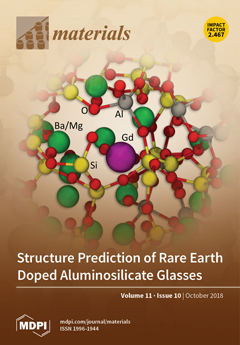Temperature-dependent and threshold behavior of Sm
3+ ions on fluorescence properties of lithium niobate (LiNbO
3, LN) single crystals were systematically investigated. The test materials, congruent LiNbO
3 single crystals (Sm:LN), with various concentrations of doped Sm
3+ ions from 0.2 to
[...] Read more.
Temperature-dependent and threshold behavior of Sm
3+ ions on fluorescence properties of lithium niobate (LiNbO
3, LN) single crystals were systematically investigated. The test materials, congruent LiNbO
3 single crystals (Sm:LN), with various concentrations of doped Sm
3+ ions from 0.2 to 2.0 mol.%, were grown using the Czochralski technique. Absorption spectra were obtained at room temperature, and photoluminescence spectra were measured at various temperatures in the range from 73 K to 423 K. Judd–Ofelt theory was applied to calculate the intensity parameters Ω
t (t = 2, 4, 6) for 1.0 mol.% Sm
3+-doped LiNbO
3, as well as the radiative transition rate,
Ar, branching ratio,
β, and radiative lifetime,
τr, of the fluorescent
4G
5/2 level. Under 409 nm laser excitation, the photoluminescence spectra of the visible fluorescence of Sm
3+ mainly contains 568, 610, and 651 nm emission spectra, corresponding to the energy level transitions of
4G
5/2→
6H
5/2,
4G
5/2→
6H
7/2, and
4G
5/2→
6H
9/2, respectively. The concentration of Sm
3+ ions has great impact on the fluorescence intensity. The luminescence intensity of Sm (1.0 mol.%):LN is about ten times as against Sm (0.2 mol.%):LN at 610 nm. The intensity of the fluorescence spectra were found to be highly depend on temperature, as well as the concentration of Sm
3+ ions in LiNbO
3 single crystals, as predicted; however, the lifetime changed little with the temperature, indicating that the temperature has little effect on it, in Sm:LN single crystals. Sm:LN single crystals, with orange-red emission spectra, can be used as the active material in new light sources, fluorescent display devices, UV-sensors, and visible lasers.
Full article






